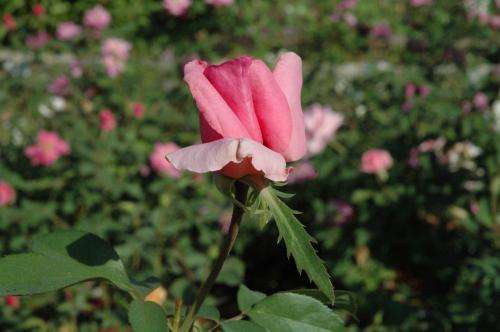Combating national rose rosette disease crisis focus of Texas study

A tiny mite carried through the wind is threatening to take down the $400 million rose industry, and researchers from California to Pennsylvania are starting a five-year study to stop it.
"Garden roses, which form the cornerstone of the multi-billion dollar landscape industry, annually generating wholesale U.S. domestic bare-root and container production valued at about $400 million," said Dr. Dave Byrne, Texas A&M AgriLife Research horticulturist and holder of the Basye Chair of Rose Genetics in College Station. "There is an urgent need to control rose rosette disease."
An almost $4.6 Specialty Crop Research Initiative grant from the U.S. Department of Agriculture-National Institute of Food and Agriculture has launched the effort, said Byrne, project director.
The disease is caused by the rose rosette virus, which is transmitted by the mite Phyllocoptes fructiphilus. Unlike other rose diseases, the virus can kill a rose within two to three years of infection, according to Byrne.
Rose rosette disease spread from the Rocky Mountains to the East Coast over several decades and is poised to obliterate the rose industry, he said, because there is no known cure.
Rose growers can spot the disease through such symptoms as shoots and foliage with an abnormal red color, stems appearing thick and succulent, rapidly elongating shoots, shoots with shortened internodes and stems with an overabundance of pliable thorns. Other symptoms may include new growth having many branches that create a "witch's broom," distorted or dwarfed leaves similar to 2,4-D injury, deformed buds and flowers, abnormal flower color, lack of winter hardiness or spiral cane growth,according to a report from the Clemson University Cooperative Extension Service.
The scientific counterattack will include working with private rose breeders to identify and develop rose rosette disease resistant breeding germplasm and molecular markers to facilitate the rapid introgression of resistance into commercial roses, developing diagnostic tools, creating a monitoring network to track the disease, developing best management practices to manage the disease, and conducting consumer and grower producer surveys to identify the preferred rose traits and the marketing or economic barriers to their adoption.
"The goal of this research project is to develop a set of best management practices to manage the disease in the short term by studies into the host-virus-vector interaction," Byrne said. "We would combine this with publications, training programs, a monitoring network and demonstrations to help people know what to look for and how to manage it.
"Finally, we will assess the risk of rose rosette disease to the industry and the benefits of the research performed," Byrne said.
He said the framework for the plan started with the industry sponsored Rose Rosette Summit in April 2013, which brought together people from all sectors of the rose industry, regulatory agencies and scientists from throughout the country to discuss the problem. This framework evolved during subsequent discussions with the industry into the research proposal. As a result, AmericanHort, an association of nursery and landscape professionals, established a Rose Rosette Disease website, which will be an outlet for the national study and action plan.
Byrne's 17-member national team will include experts in the area of best management practices, diagnostics, plant breeding and genetics, molecular genetics, plant pathology, entomology, educational extension, and marketing and economics. This team -with industry support – will also collaborate with rose breeders in California, Pennsylvania, Connecticut, and Wisconsin, and will collaborate with experts at the Plant Research Institute in The Netherlands, Byrne said.
Provided by Texas A&M University

















